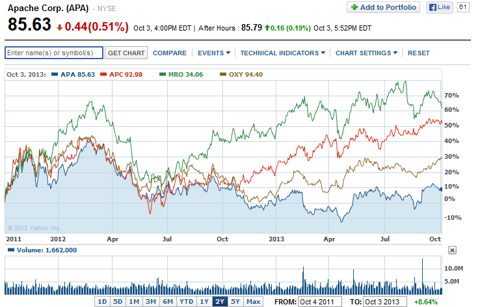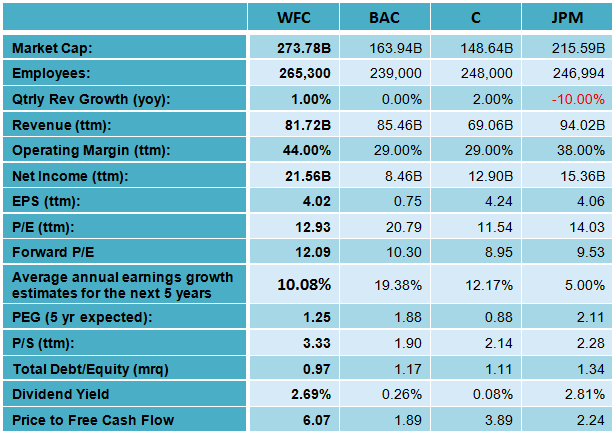Buy The LowDividend Yield And Sell The HigherYielding Stoc Apache Corporation (NYSE APA)
Post on: 20 Апрель, 2015 No Comment

Oil prices are fighting their way up and oil and gas companies are attracting a lot of attention for that matter. On the other side, investors are hunting for the companies paying a high-dividend yield as they believe that these high-yield giants will pay them off well in the coming quarters. The capital return potential is sometimes ignored while making investment decision. Apache (NYSE:APA ) and Encana (NYSE:ECA ) are the perfect examples to elaborate this misconception. Apache is trading at $72.62 and pays a dividend yield of 1.1% whereas Encana is trading $18.74 and pays a dividend yield of 4.1%. The point to ponder is, if these dividend yields imply the right rating for these companies.
Apache
Apache Corporation is an independent energy company that explores, develops and produces natural gas, crude oil and natural gas liquids. As of April 16, Apache has a market cap of $28.45 billion. The company has a P/E ratio of 14.76, below the S&P 500 P/E ratio of 18.00. Since the beginning of 2013, Apache has lost 7.49% in the stock market. The stock currently trades at a valuation that is hard to ignore. Let’s have a look at a few details:
- APA’s revenue growth has slightly outpaced the industry average of 1.3%. The company’s three-year average revenue growth rate stands at 25.6% compared with the industry average of -2.8%. This growth in revenue does not appear to have trickled down to the company’s bottom line as its earnings per share declined from $8.46 in 2010 to $4.92 in 2012.
- The current debt-to-equity ratio of 0.39 is below the industry average of 0.5, implying that there has been a successful debt management despite operating in a highly capital intensive industry.
- The company’s operating margin of 28.6% is higher than the industry average of 24.9%. Due to the decline in the stock price, the company has a price-to-book multiple of 1, lower than the industry’s multiple of 1.8. The price-to-sales multiple is 1.7 compared with the industry’s multiple of 2.8.
- The analysts’ estimate a one-year target price of $99.56, a potential capital return of 37.1%.

Encana
Encana Corporation and its subsidiaries engage in the exploration, development, production and marketing of natural gas, oil and natural gas liquids. As of April 16, ECA has a market cap of $13.8 billion. The company has a P/E ratio of -5.2, inconclusive due to the negative earnings reported in the recent fiscal year. Since the beginning of 2013, Encana has lost 2.29% of its market price, though we expect a further stock price decline.
- Encana’s three-year average revenue growth rate is posted at -22.6%. Currently the debt-to-equity ratio of 1.4 is quite high overall and when compared with the industry average, suggesting that the current management of debt levels should be re-evaluated.
- The net margin of -54.2% is currently lower than what is desirable. Along with the weak results of the net margin, the operating margin of -85.6% has significantly underperformed the industry average.
- The earnings per share of the company has significantly deteriorated over the last three years, dipping from a level of $2.03 in 2010 to $-3.79 in 2012. During the past fiscal year, ECA reported a bottom line of $-2 billion versus $128 million in the prior year.
- For the first time since 2003, the company reported negative return on equity (-25.85%) and return on assets (-10.62%). The revenue decreased by 39% year over year and we do not expect the company to recover from this decline any time soon.
- Book value per share has declined from 11.66 in FY12 to 7.2 in FY13. Over the same period, free cash flow per share slightly improved from -0.73 to -0.5. The fundamentals of the company have been deteriorating since FY10. FY13 was a record year of company underperformance.
Based upon the facts illustrated above, we have rated ECA as a sell and APA as a buy, despite their dividend yields. The recent stock price performance and company’s dynamics play a huge role in making the right bets for investment and APA has strong fundamentals compared with ECA.
Disclosure: I have no positions in any stocks mentioned, and no plans to initiate any positions within the next 72 hours. I wrote this article myself, and it expresses my own opinions. I am not receiving compensation for it (other than from Seeking Alpha). I have no business relationship with any company whose stock is mentioned in this article.
Since you’ve shown interest in APA, you may also be interested in














